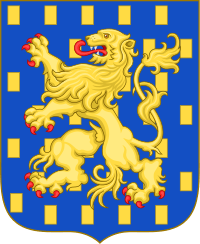Geoffrey, Count of Eu
| Geoffrey, Count of Eu | |
|---|---|
|
Arms of the Counts of Eu from the House of Normandy: D'azur, au lion d'or,l'écu semé de billettes d'or | |
|
Issue Gilbert | |
| Noble family | de Clare |
| Father | Richard I of Normandy |
| Born | 962 |
| Died | c. 1010 |
Geoffrey of Brionne (962 - c. 1010), also called Godfrey was Count of Eu and Brionne[lower-alpha 1] in the late tenth and early eleventh centuries.
Life
He was a son of Duke Richard I of Normandy,[1] by an unnamed wife or concubine.[lower-alpha 2][5] The county of Eu was an appanage created for Geoffrey by his brother Richard II of Normandy in 996 as part of Richard's policy of granting honors and titles for cadet members of his family.[5] The citadel of Eu played a critical part of the defense of Normandy;[6] the castle and walled town were on the river Bresle, just two miles from the English Channel. It had long been an embarkation point for England and in time of war was often one of the first places attacked.[6]
The castle of Brionne had been held by the Dukes of Normandy as one of their own homes but Richard II also made a gift of Brionne to his half-brother Geoffrey,[lower-alpha 3] who held it for life passing it to his son Gilbert and was only returned to the demesne of the Duke after his murder.[7]
Both Geoffrey (Godfrey) and his son Gilbert are styled counts in a diploma to Lisieux given by Duke Richard II, but without territorial designations.[8] Geoffrey died c. 1010.[9]
Issue
Geoffrey was the father of:
- Gilbert, Count of Brionne, who succeeded his father as Count of Eu & Brionne.[10]
Notes
- ↑ While there is little doubt Geoffrey (Godfrey) was Count of Eu, there is an open question as to whether Geoffrey was ever "Count" of Brionne. See: Douglas, Earliest Norman Counts, EHS 61, No. 240 (1946), p.134.
- ↑ The early Normans followed the Viking custom of marriage called more danico that they considered a legitimate form of marriage.[2] It was the Church that considered this the same as concubinage.[3] Legitimacy would not have been an issue at this time.[4]
- ↑ Orderic in a speech attributed to Roger, Count of Mullent to Robert II, Duke of Normandy, in asking for the castle of Brionne stated that it was Duke Richard the elder (I) who gave Brionne to his son Geoffrey (Godfrey). See Ordericus Vitalis, Ecclesiastical History, Trans. Forester, Vol. II (1854), p. 490.
References
- ↑ J.H. Round, The Family of Clare, The Archaeological Journal, Vol. LVI, Second Series Vol. VI, (1899), pp. 223-4
- ↑ Philip Lyndon Reynolds, Marriage in the Western Church: The Christianization of Marriage During the Patristic and Early Medieval Periods (Boston: Brill, 2001), p. 110
- ↑ David Crouch, The Normans: The History of a Dynasty (London: Hambledon Continuum, 2007), p. 24
- ↑ Frank Stenton, Anglo-Saxon England (Oxford: Oxford University Press, 1971), p. 555; David Crouch, The Normans: The History of a Dynasty (London: Hambledon Continuum, 2007), p. 60
- ↑ 5.0 5.1 Edmund Chester Waters, The Counts of Eu, Sometime Lords of the Honour of Tickhill, The Yorkshire Archaeological and Topographical Journal, No. 9 (1886), p. 262
- ↑ 6.0 6.1 Edmund Chester Waters, The Counts of Eu, Sometime Lords of the Honour of Tickhill, The Yorkshire Archaeological and Topographical Journal, No. 9 (1886), p. 261
- ↑ The Gesta Normannorum Ducum of William of Jumieges, Orderic Vitalis, and Robert of Torigni, Vol. II, Ed. & Trans. Elizabeth M.C. Van Houts (Clarendon Press, Oxford, 1995), pp. 228-9
- ↑ David Douglas, The Earliest Norman Counts, The English Historical Review, Vol. 61, No. 240 (May, 1946), p. 134
- ↑ Edmund Chester Waters, The Counts of Eu, Sometime Lords of the Honour of Tickhill, The Yorkshire Archaeological and Topographical Journal, No. 9 (1886), p. 257
- ↑ George Edward Cokayne, The Complete Peerage of England Scotland Ireland Great Britain and the United Kingdom, Extant Extinct or Dormant, Vol III, Ed. Vicary Gibbs (The St. Catherine Press, Ltd., London, 1913), p. 242
